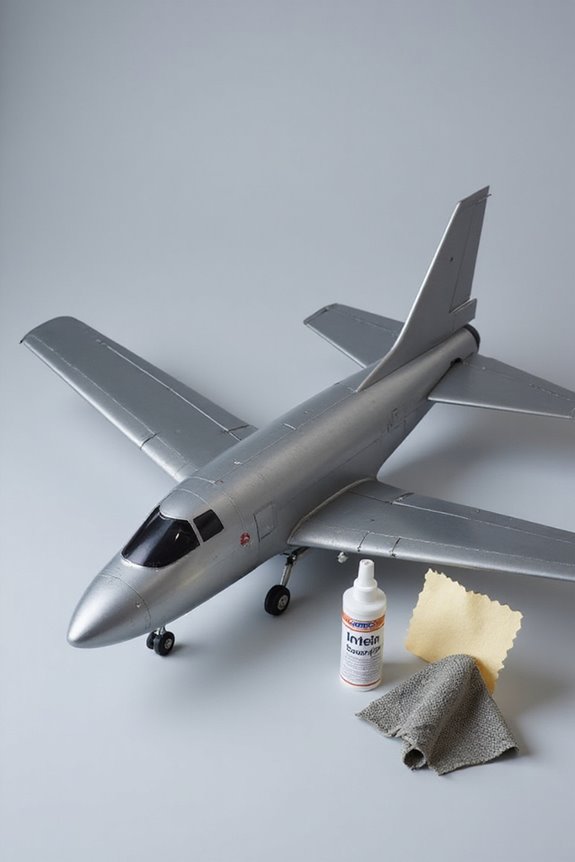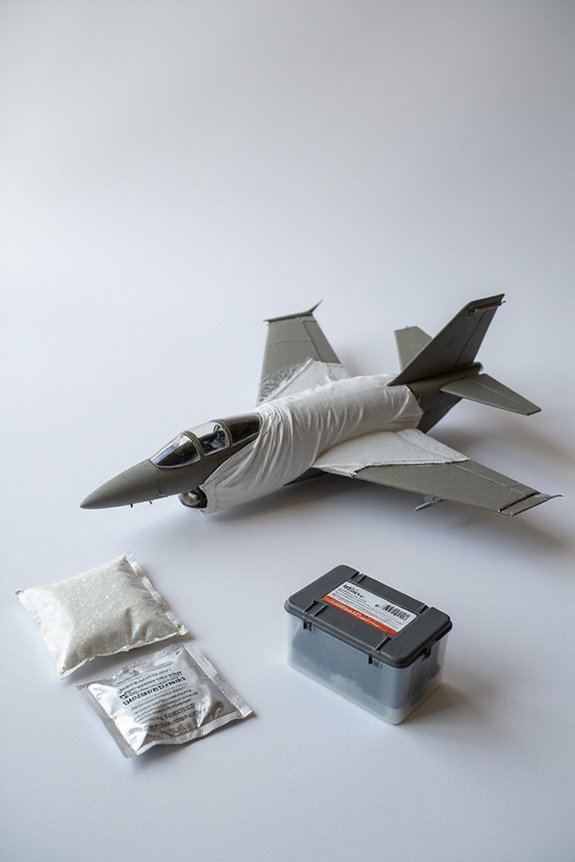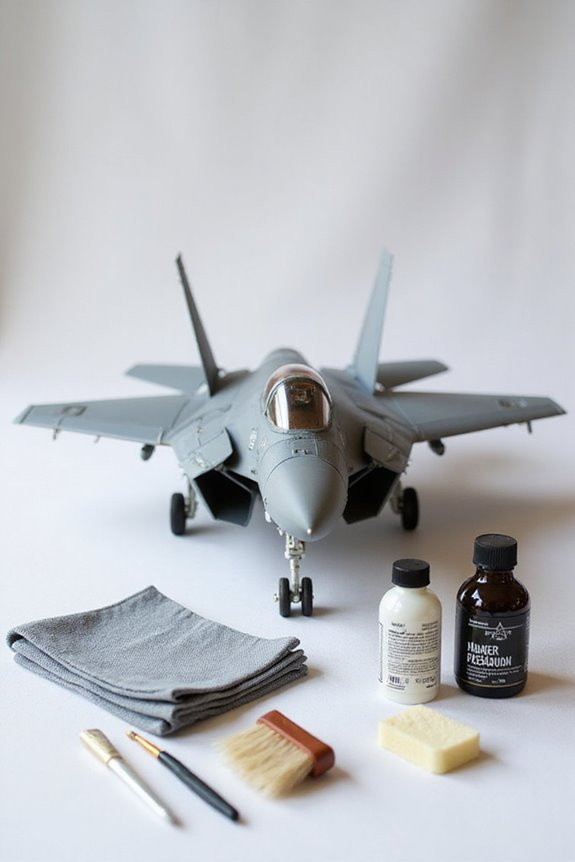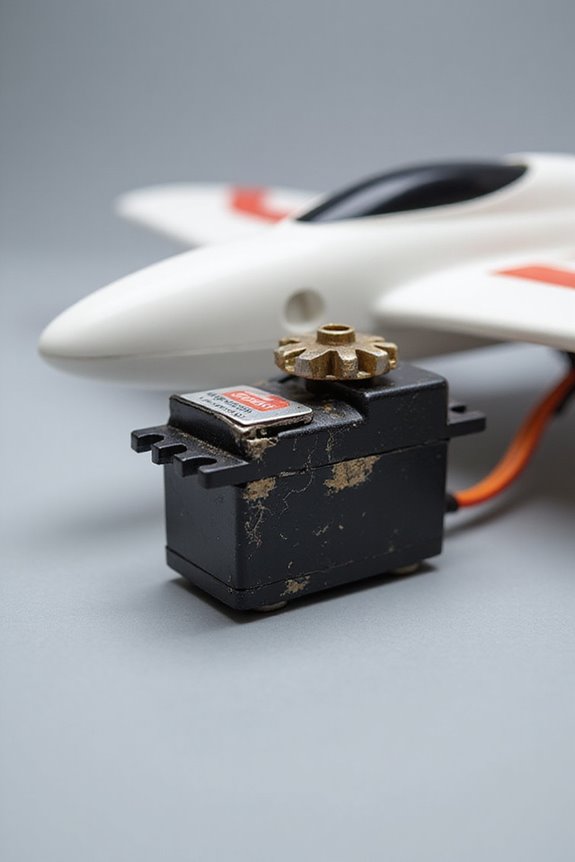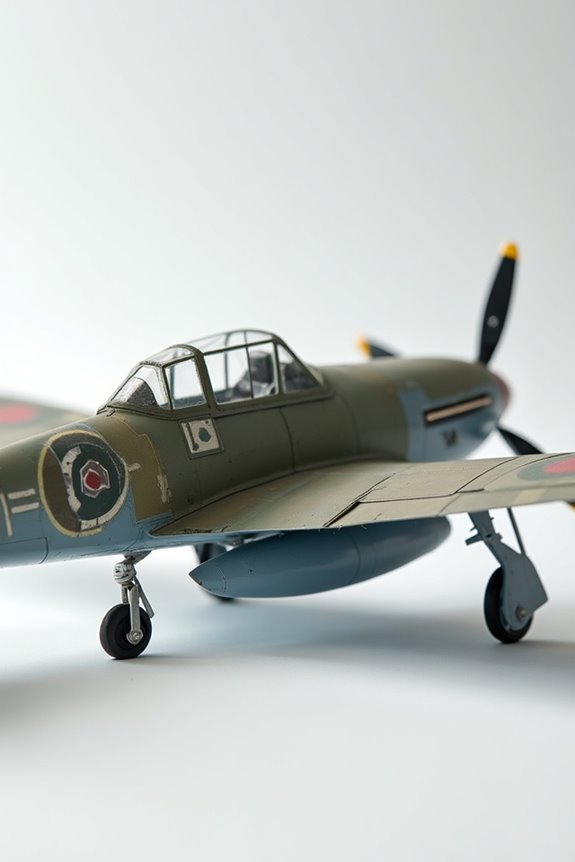To prevent corrosion in our RC planes, we should start with the right materials like aluminum and carbon fiber, which resist rust. Regular inspections are key to catching issues early, kind of like checking your car’s oil before a road trip. Don’t forget effective coatings like urethane primers, and consider using chemical inhibitors to form protective barriers. Protecting our planes from moisture and storing them properly can make a world of difference. There’s even smarter technology that can help us monitor corrosion too!
Key Takeaways
- Use corrosion-resistant materials like high-quality aluminum, plastics, or carbon fiber during construction for enhanced durability.
- Apply high-performance coatings such as urethane and epoxy primers to protect surfaces from moisture and chemicals.
- Implement a regular maintenance schedule to clean and inspect your RC plane for signs of corrosion or wear.
- Store your plane in a controlled environment with proper temperature and humidity to reduce stress on materials.
- Integrate monitoring sensors to detect early signs of corrosion and optimize maintenance efforts based on real-time data.
Material Selection for Corrosion Resistance
When we plunge into building our RC planes, one of the first things we need to contemplate is material selection for corrosion resistance. Choosing materials with the right properties can save us headaches later. A traditional go-to is aluminum, known for its high strength-to-weight ratio. Its alloys form a protective oxide layer, making it less prone to rust.
However, plastics like Lexan and Coroplast don’t corrode—perfect for outdoor play! And let’s not forget carbon fiber. This lightweight wonder doesn’t suffer from rust and offers fantastic strength. It’s all about alloy selection and understanding how these materials behave in different environments. Additionally, material quality is crucial as high-quality options enhance durability and performance. So, let’s get our materials right—your RC plane deserves it!
Effective Coating and Surface Treatments
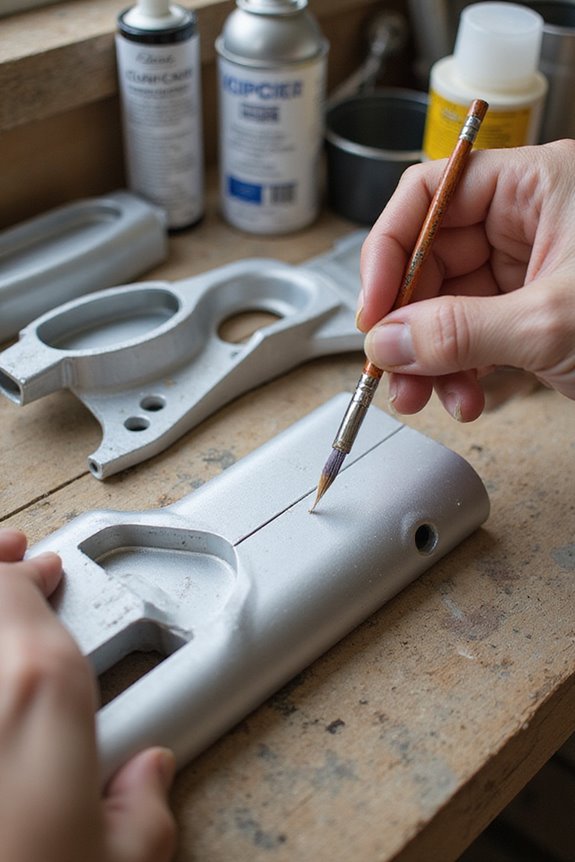
To keep our RC planes flying high and looking sharp, effective coating and surface treatments are key. We can use high-performance urethane primers for superb corrosion inhibition. They stick well to topcoats and comply with eco-friendly regulations too. For a glossy finish, those urethane topcoats are a favorite, resisting chemicals and abrasion like a champ.
Additionally, epoxy primers are excellent for details and subassemblies, offering strong adhesion and corrosion resistance. Don’t forget about polyurethane systems—they provide durable protection against UV light and stains. If we want to get fancy, advanced metal matrix coatings are also an option. With these coating techniques, our planes can remain not just functional but also fabulous. Plus, who doesn’t love a shiny RC plane?
Importance of Maintenance and Regular Inspection
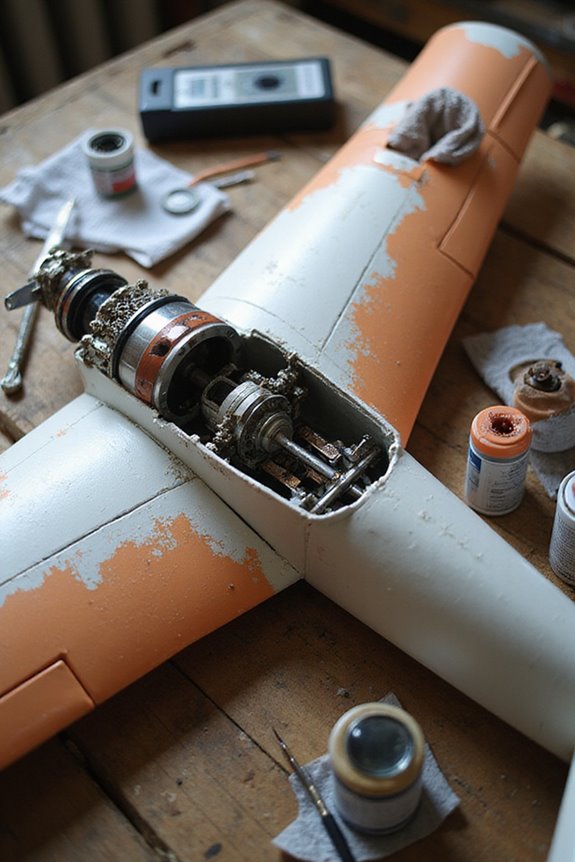
Even the coolest RC planes need a little TLC, and that’s where regular maintenance and inspections come into play. We can’t just throw them in the air and hope for the best! Keeping a solid maintenance schedule guarantees we’re cleaning off dirt, salt, and moisture that can lead to corrosion. Those pesky contaminants are sneaky!
Using effective inspection techniques helps us catch signs of trouble before they spiral into big issues. A thorough check of paint and fasteners can save us a headache later. Inspecting those vulnerable areas stops corrosion in its tracks. Plus, regular wipe-downs keep things spick and span, reducing the chances of localized damage. So, let’s stay proactive and keep our planes flying high!
Environmental Protection Strategies
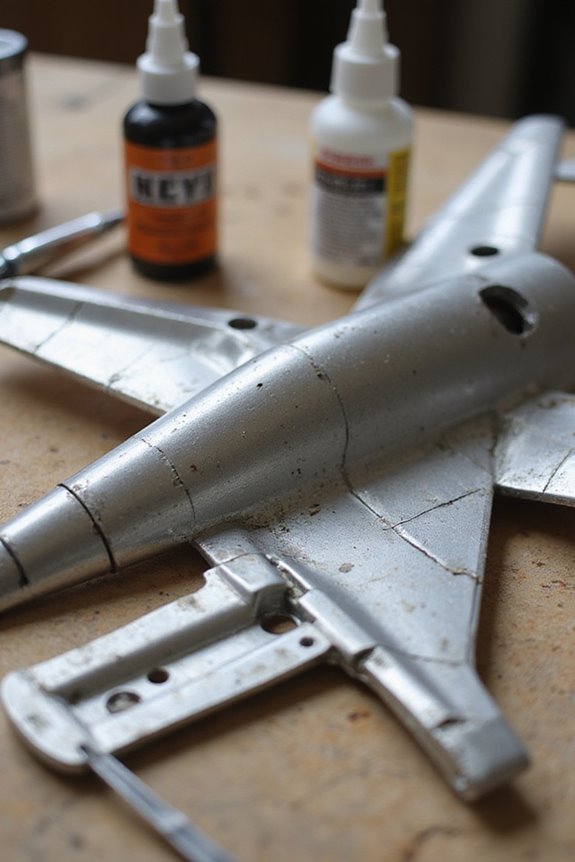
Though we love the thrill of flying our RC planes, we can’t ignore the impact of Mother Nature on their longevity. To keep corrosion at bay, we need to combat various environmental factors. First, storing our planes in a controlled environment between 60-75°F helps reduce material stress.
We should also maintain humidity around 40-60% to prevent moisture accumulation. It’s essential to shield our planes from rain or snow, as water can short-circuit electronics and speed up corrosion. Using moisture barriers like protective covers can make a big difference too.
Lastly, avoiding prolonged direct sunlight protects the materials from degradation. By taking these steps, we’re ensuring our planes stay in top shape for many thrilling flights ahead!
Utilizing Chemical Inhibitors
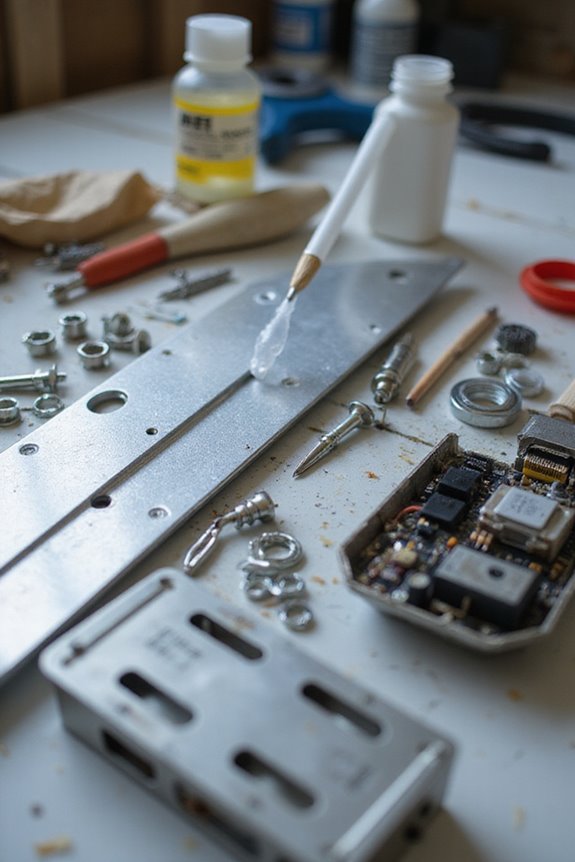
After we’ve fortified our RC planes against environmental threats, it’s time to fortify them chemically. Chemical inhibitors are our secret weapon against corrosion. They form a protective film, blocking moisture and oxygen from our precious metal parts.
We can choose organic inhibitors like amines, which create hydrophobic barriers that keep our steel and aluminum safe. Then, there are inorganic inhibitors like chromates, which react with metals to form tough, corrosion-resistant layers.
Let’s not forget about polar bonding inhibitors—they repel moisture like a superhero! For our electronic connections, they create non-conductive films that keep oxidation at bay. Just like applying sunscreen before a fun day out, a little preventive maintenance now saves us from headaches later. Let’s keep those planes flying!
Advanced Technologies for Corrosion Prevention
While we’ve already armed our RC planes with chemical barriers against corrosion, we can take things up a notch with advanced technologies. Multi-layer corrosion prevention systems can cut corrosion rates by up to 90%. Think of them as cozy blankets for your plane’s vulnerable points!
But wait, there’s more! Sensor integration plays an essential role in this. Electrochemical sensors keep tabs on corrosion in real-time, while ultrasonic sensors shout warnings about thinning materials.
On top of that, predictive modeling helps us foresee potential trouble spots. By simulating moisture flow and analyzing past data, we can predict where corrosion might strike. So, let’s leverage these tech wonders to keep our RC planes flying strong and corrosion-free!
Designing for Moisture Control
When it comes to designing our RC planes for moisture control, we want to think like detectives tracking down every possible source of trouble. First, we need to identify those sneaky moisture pathways where condensation and spills can creep in. By managing vapor diffusion, we can use coatings and materials that keep moisture at bay—especially in those tricky hollow sections.
Next, let’s guarantee our assemblies don’t trap water. Designing drainage systems to divert moisture away from sensitive electronics is key. Proper insulation can help, too! We should position circuit boards vertically to promote moisture runoff. Basically, we’re creating a moisture fortress for our planes. With careful planning and smart material choices, we’ll keep corrosion at a distance—like an ex you don’t want to see again!
Protective Coverings and Storage Solutions
Protective coverings and smart storage solutions are our RC planes’ best friends, especially when it comes to keeping corrosion at bay. For covering techniques, options like iron-on films are fabulous; they shrink and grip, creating a tight seal that moisture hates. Using layers—like silkspan under UltraCote—can add strength and moisture resistance without breaking the bank.
Now, let’s talk storage materials. We should store our planes in dry areas to avoid metal oxidation and wood swelling. A breathable cover can block dust but still allows air to circulate—think of it as a cozy blanket that breathes! Elevating our planes off the ground minimizes exposure to moisture. Additionally, ensuring the use of high-quality landing gear can further protect the airplane structure from wear and corrosion during landings. With these strategies, our airplanes will stay safe and corrosion-free!
Regular Cleaning and Lubrication Practices
Maintaining our RC planes isn’t just for show; it’s essential for keeping them in top shape. A solid cleaning schedule guarantees we use mild, neutral pH cleaners to protect aluminum surfaces. Let’s avoid abrasives and stick to water-based, non-toxic solutions. Remember, we want these beauties to shine, not to be scratched!
When it comes to lubrication techniques, we need to be diligent. Regularly lubricate moving parts without going overboard—too much can attract dust, like a magnet! And don’t forget to clean surfaces first; dirt trapped under grease is the enemy. So, let’s stay on top of our cleaning and lubrication practices. A little effort now means fewer headaches later, and our planes will thank us for it!
Monitoring Corrosion With Smart Technologies
While keeping an eye on corrosion may sound tedious, it’s essential for our RC planes’ longevity and performance. Luckily, smart technologies can help us out. With sensor integration, we can use various types of sensors like eddy current and thermography to monitor corrosion signs automatically.
These sensors constantly analyze data, giving us insights into the condition of our planes. Think of it as our planes’ way of texting us updates!
We can also implement condition-based maintenance, allowing us to schedule repairs based on real-time data rather than guessing. By connecting multiple sensors, we get a thorough view of our RC planes’ health. That way, we can focus on flying instead of worrying. Let’s embrace these advancements, shall we?
Frequently Asked Questions
How Can I Tell if My Plane Has Started to Corrode?
We should perform regular corrosion inspections, looking for signs like rust or discoloration. Spotting metal fatigue, such as cracks or loosened parts, can prevent larger issues, ensuring our RC plane stays in top shape.
What Are the Signs That Protective Coatings Need Reapplication?
Have you noticed your plane’s looks changing? We should keep an eye on corrosion indicators like dull coatings or scratches. When protective coating wears off, reapplication’s essential to keep our aircraft in top shape.
Can I Use Household Products for Cleaning My RC Plane?
Sure, we can use household cleaners for cleaning our RC plane, but we should choose safe cleaning tools. Gentle abrasives and non-ammonia cleaners work well, while avoiding harsh products that might damage surfaces is essential.
Are There Specific Diets for RC Planes to Help Prevent Corrosion?
Picture our planes thriving in the air, not worn down by corrosion. While there aren’t specific diets, mindful dietary considerations—like regular cleaning and protective coatings—are key for corrosion prevention, ensuring our models soar without worry.
How Often Should I Store My RC Plane in a Hangar?
To keep our RC planes safe, we should prioritize consistent hangar storage. By maintaining ideal storage conditions and regularly checking hangar maintenance, we can greatly reduce risks from environmental factors that might affect our planes.

